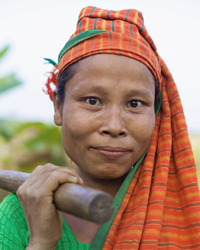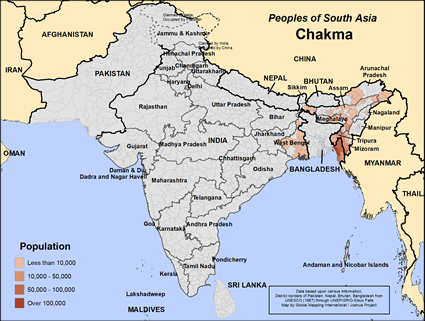Chakma in Bangladesh

Photo Source:
Asia Harvest-Operation Myanmar
|

Map Source:
Anonymous
|
| People Name: | Chakma |
| Country: | Bangladesh |
| 10/40 Window: | Yes |
| Population: | 542,000 |
| World Population: | 792,000 |
| Primary Language: | Chakma |
| Primary Religion: | Buddhism |
| Christian Adherents: | 7.47 % |
| Evangelicals: | 0.00 % |
| Scripture: | Complete Bible |
| Ministry Resources: | Yes |
| Jesus Film: | Yes |
| Audio Recordings: | Yes |
| People Cluster: | South Asia Tribal - other |
| Affinity Bloc: | South Asian Peoples |
| Progress Level: |
|
Introduction / History
Chakma people inhabit Bangladesh and adjoining areas of northeast India. They are the largest Buddhist group in that Muslim-dominated country. The Chakma are not the same as the smaller Chak tribe, who inhabit areas further south.
The Chakma have inhabited the Chittagong Hill Tracts since long before the region became part of the Mughal empire in 1666. Buddhism flourished in Bangladesh from the 5th to 12th centuries. Since the 13th century, Buddhism has been confined to the Chittagong area. The Chakma 'continued to acknowledge the suzerainty of the Arakanese king until 1784 '. They have long found themselves at odds with the predominantly Muslim Bengalis. The construction of the Kaptai Dam in the 1960s caused 18,000 Chakma people to lose their homes, and this is believed to be the origin of the present problems. Since the mid-1970s the Chakma have been involved in a secretive guerilla war against Bangladeshi soldiers. The fighting stems from the influx of large numbers of Bengali settlers, who have moved into the Chittagong area and taken over Chakma land by force.
What Are Their Lives Like?
The government does little to stop the illegal settlers, and the Chakma have fought back out of frustration as they see their lives being rapidly decimated. In 1987, Amnesty International reported 'arbitrary arrests, torture and unlawful killings' of tribe members by security forces. Thousands of Chakma have been killed, hundreds of women and girls raped, and Buddhist temples smashed and looted. Tens of thousands of Chakma refugees have fled across the border into India.
What Are Their Beliefs?
According to K S Singh, 'The Chakma are Buddhists and worship Lord Buddha. At the family level they worship deities like Lakshmi and Ganga. The monk, who may be from another Buddhist community, acts as a religious teacher and performs various rites.'
What Are Their Needs?
According to the India Missions Association, most Chakma people live in a part of India where there are believers nearby, and not just any believers, but people who follow Christ with all their hearts. In Bangladesh, the Christian presence among the Chakma is scarcer, although there are small pockets of believers in scattered villages. Experiencing turmoil and an uncertain future, they need the inner peace and hope that only faith in Christ can bring.
Prayer Points
Pray for the Lord to thrust out strong Christian believers from India to reach the Chakma people in Bangladesh.
Pray for the Chakma people in Bangladesh to become Christ's faithful ambassadors to others in that Muslim country.
Pray for the Chakma church to be defined by holiness, commitment to the ways of Christ, and a willingness to spread his name throughout South Asia.